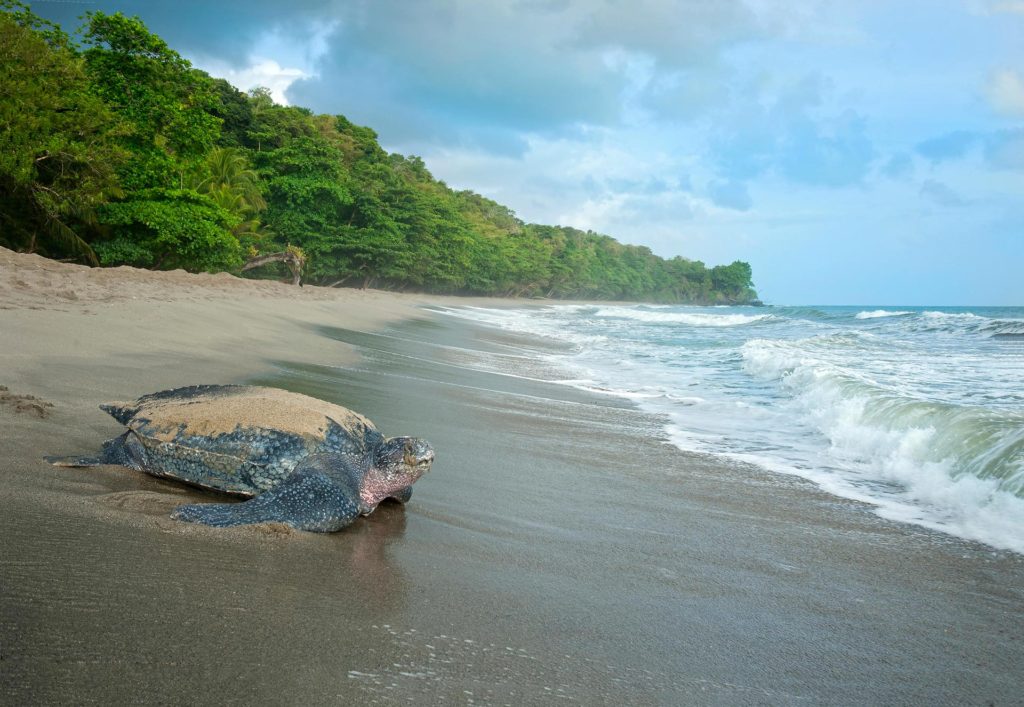When tiny turtle hatchlings dig their way out from nests deep beneath the sand, they face long perilous odds to survive. Their first few moments on the beach are among the most dangerous. Popping their little heads up, they’ll search for the natural light horizon over the shoreline and scramble toward the surf, where they’ll be swept away by the ocean waves and begin the next leg of their odysseys.
Any man-made light — from beachfront properties, streetlights, cars, flashlights — or fire can disorient hatchlings, leaving them as easy prey for would-be predators like birds and crabs. Anything that impedes their emergence and speedy progress to the sea — from plastics to sandcastles to Sargassum seaweed — makes those long survival odds even longer.
Fewer than one in 1,000 will make it to mating age. Those females that do — and can manage to avoid becoming entangled in gillnets or fishing gear — will travel thousands of miles back to the shorelines on which they were born to begin the cycle of life once more.
It’s a sight to behold when these nesting mothers return — especially the massive, majestic leatherbacks, which can reach up to 10 feet in length and weigh up to 2,000 pounds. Seeing them heave themselves on to the sand, carve out their nests, work to disguise them, and then slowly make their way back to the sea can take your take your breath away…and leave a sizeable lump in your throat.
Something about the vulnerability and resilience of these nesting mothers and baby hatchlings moves people very deeply. Something about it feels sacred.
It’s why at this time of year — when hatchlings begin emerging in their numbers — giving these babies and their mothers the best chance of survival is one of the main jobs of volunteers in community-based organisations (CBOs) across Trinidad & Tobago. They dedicate months of their lives each season to serve as their advocates and protectors.
Leatherbacks, hawksbills and greens also nest on other popular beaches like Las Cuevas, Maracas, Mayaro, Manzanilla, Lambeau, Man O’ War Bay, and Pigeon Point
Sea turtles have been around for 100 million years, since the time of the dinosaurs. Five of the seven species that exist today visit Trinidad & Tobago’s coasts — loggerheads, olive ridleys, hawksbills, greens, and leatherbacks, with the latter three nesting on the islands’ beaches.
For the leatherback — listed as endangered — nesting season officially runs March through August, though stray leatherbacks can nest as late (or as early) as December and January. For critically endangered hawksbills and greens, however, nesting activity usually begins around May and can run to November.
With hatchlings emerging roughly six to eight weeks later, the islands are home to nesting-related activity for most of the year, and offshore foraging activity year-round. It’s an important duty, as the islands have become a focal point of leatherback conservation globally. They’ve become the most important nesting ground in the western hemisphere, and the last great hope for the survival of leatherback populations in the northwest Atlantic.
“It’s all eyes on Trinidad,” says Suzan Lakhan-Baptiste, a founding member and now Managing Director of the Matura-based Nature Seekers — one of the award-winning community-based organisations that has made Trinidad & Tobago a success story for the leatherback and a model for conservation initiatives across the region. “This is a resource that is not just Trinidad’s concern, but an internationally shared one.”
Nesting populations in neighbouring French Guiana and Suriname, as well as across the Pacific, have almost completely collapsed in recent years, threatening the survival of leatherbacks globally. The tireless work of volunteers in Trinidad & Tobago has managed to defy these global trends, making the islands — particularly the rookeries of Trinidad’s northeast — the world’s second largest nesting ground for leatherbacks, after Gabon in west Africa.
Grande Rivière — a kilometre-long beach in a tiny fishing village on Trinidad’s remote northeast coast — is the densest leatherback nesting ground in the world. Over 500 were recorded on this beach on one night several years ago. There are similar numbers on the much longer 8.8km stretch at Matura, where 300 to 400 leatherbacks can nest on any given night.
It’s estimated more than 6,000 leatherbacks (possibly up to 10,000) nest across the island over the season, especially at Grand Rivière, Matura, Fishing Pond (in Trinidad) and Stonehaven and Courland (in Tobago). But leatherbacks, hawksbills and greens also nest on other popular beaches like Las Cuevas, Maracas, Mayaro, Manzanilla, Lambeau, Man O’ War Bay, and Pigeon Point. There have been nesting events recorded even on Trinidad’s south coast and offshore islands.
•
Despite these successes, the threats to turtles — and to the CBOs’ conservation work — are significant. In addition to plastics, Sargassum and fishing nets, chief among them are poaching, climate breakdown (including beach erosion), and indiscriminate coastal development and beach management. It’s why each turtle that can successfully nest and each hatchling that can make it into the sea impact the survival of the species. So does each turtle lost to bycatch or poaching.
Beyond their intrinsic value as key indicator species that both reflect and help ensure the health of the world’s oceans and marine ecosystems, these turtles also bring significant economic benefit to the communities that have rallied to protect them. In some, the conservation work has expanded to include other species, and sustainability initiatives like reforestation.
Before the pandemic, both Matura and Grande Rivière could see 10,000–15,000 turtle-watching visitors each year. With leatherbacks nesting up to 10 times per season (hawksbills up to five) — with 80–100 eggs per nest — each individual turtle and each nest carries real value.
“We can tell at the end of the season how many people actually came to Matura, how many people viewed that animal, and — because we make every leatherback an individual by tagging her — how much revenue was generated from that one turtle,” explains Lakhan-Baptiste. “And once they keep coming back, revenue is generated as a result.”
Those who’ve had the experience of turtle-watching often become evangelists for the animals, so that word-of-mouth is also significant. “The 20 years I’ve been doing this, we have eliminated poaching from the dialogue — not from enforcement, but from the guests who come annually,” explains Kevin Muhammad of the Grande Rivière Nature Tour Guides Association (GRNTGA). “Over the last decade, that’s over 100,000 people who have become advocates.”
Even though Tobago’s nesting numbers are much smaller, they’ve also seen the economic benefits of turtle tourism. “Outside of the main tourist season, which finishes around the end of April, they’ll still continue to get people coming in to see turtles,” explains Giancarlo Lalsingh, a long-time conservationist who was Program Manager of Save Our Sea Turtles (SOS) Tobago for several years. And visitors, of course, need places to stay, places to eat, and ways to get around.
•
Since 1965 — when the first sea turtle monitoring programme was led by the University of the West Indies with the Trinidad & Tobago Field Naturalists’ Club — several groups have emerged to help protect turtles in their various communities. But there is tremendous diversity among them.
Some include monitoring of green and hawksbill turtles, most don’t. Some operate tours and are therefore able to generate modest revenue; many don’t. Some have strong governance and administrative capacity — even alignments with overseas entities; many don’t. The beaches also vary significantly in length, accessibility, amenities, and whether they’re protected (only three in Trinidad are, and none in Tobago).
What they have in common, however, are the challenges in doing this work: funding; manpower; equipment (from tags and scanners to vehicles); and effective partnerships with state agencies, on whom they depend for policy, enforcement, data coordination and analysis, maintenance of roads and beaches and — for those eligible — access to financing through the nation’s US$1 billion Green Fund.
There are also gaps in monitoring and evaluation. Many nesting beaches around both islands are not sufficiently monitored or patrolled — if at all. And while significant and invaluable attention has been put on the leatherback, there’s been inadequate focus on the smaller and even more vulnerable green and hawksbill turtles that nest across both islands — sometimes on the same beaches as leatherbacks, but often on very different ones. Poaching of the leatherback has fallen to near zero, but hawksbills and greens remain a frequent target for their meat and their shells.
Offshore monitoring is another area in need of attention. As a result, the data on leatherback populations is incomplete, and there isn’t enough to accurately assess the greens or hawksbills, even though the latter could be “quite a significant, important population”, according to Michelle Cazabon-Mannette, a sea turtle researcher and director of SpeSeas.
SpeSeas and SOS Tobago have partnered with ProTECTOR of Honduras on the TURT mobile app to help address the offshore data gap. They hope citizens and visitors — especially divers, tour guides, snorkellers, fisherfolk, and boaters — will use it to submit photos of sea turtle sightings on beaches or at sea. It will help researchers identify individual turtles, and understand more about their movements, health, and survival.
The global fight to protect biodiversity and arrest climate breakdown is, without overstatement, an existential one. But these groups show what’s possible when people come together for a common good. In many ways, they face odds as long as a baby hatchling’s as it heads for the horizon. It is incumbent on all of us to give them every chance of success.
How you can help the turtle conservation effort
Go turtle-watching
You can book tours through groups like Nature Seekers, the Grande Rivière Nature Tour Guides Association, the Las Cuevas Eco Friendly Association, and SOS Tobago’s partners. They usually can arrange any necessary permits.
Donate & volunteer
You can make financial and in-kind donations, or volunteer your time/expertise in a range of ways. Contact CBOs like SOS Tobago and Nature Seekers, or the Turtle Village Trust.
Turtle conservation tips
• If you see a turtle — on land or at sea — take photos of its head and upload it to the TURT app.
• Don’t drive or light fires on nesting beaches; don’t use stake umbrellas; and don’t litter.
• Break down sandcastles before you leave the beach.
• Give nesting mothers lots of space and quiet, and don’t use bright lights around them or hatchlings.

